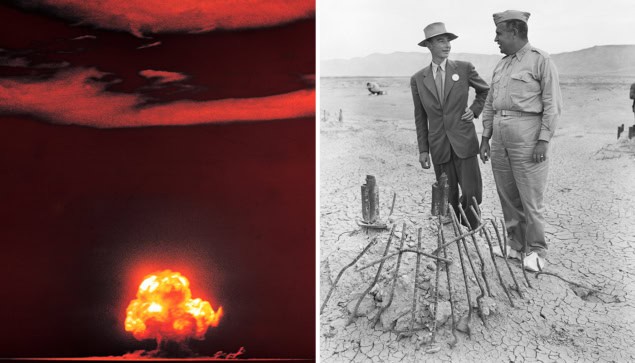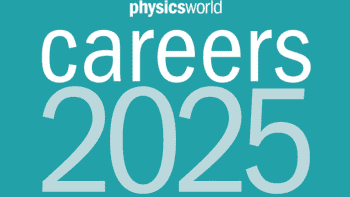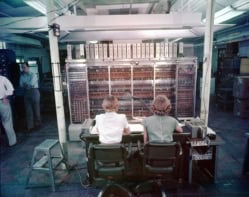Andrew Robinson reviews Destroyer of Worlds: the Deep History of the Nuclear Age 1895–1965 by Frank Close

The title of particle physicist Frank Close’s engaging new book, Destroyer of Worlds, refers to Robert Oppenheimer’s famous comment after he witnessed the first detonation of an atomic bomb, known as the Trinity test, in July 1945. Quoting the Hindu scripture Bhagavad Gita, he said “Now I am become death, the destroyer of worlds.” But although Close devotes much space to the Manhattan Project, which Oppenheimer directed between 1942 and 1945, his book has a much wider remit.
Aimed at non-physicist readers with a strong interest in science, though undoubtedly appealing to physicists too, the book seeks to explain the highly complex physics and chemistry that led to the atomic bomb – a term first coined by H G Wells in his 1914 science-fiction novel The World Set Free. It also describes the contributions of numerous gifted scientists to the development of those weapons.
Close draws mainly on numerous published sources from this deeply analysed period, including Richard Rhodes’s seminal 1988 study The Making of the Atomic Bomb. He starts with Wilhelm Röntgen’s discovery of X-rays in 1895, before turning to the discovery of radioactivity by Henri Becquerel in 1896 – described by Close as “the first pointer to nuclear energy [that was] so insignificant that it was almost missed”. Next, he highlights the work on radium by Marie and Pierre Curie in 1898.
After discussing the emergence of nuclear physics, Close goes on to talk about the Allies’ development of the nuclear bomb. A key figure in this history was Enrico Fermi, who abandoned Fascist Italy in 1938 and emigrated to the US, where he worked on the Manhattan Project and built the first nuclear reactor, in Chicago, in 1942.
Fermi showed his legendary ability to estimate a physical phenomenon’s magnitude by shredding a sheet of paper into small pieces and throwing them into the air
Within seconds of seeing Trinity’s blast in the desert in 1945, Fermi showed his legendary ability to estimate a physical phenomenon’s magnitude by shredding a sheet of paper into small pieces and throwing them into the air. The bomb’s shock wave blew this “confetti” (Close’s word) a few metres away. After measuring the exact distance, Fermi immediately estimated that the blast was equivalent to about 10,000 tonnes of TNT. This figure was not far off the 18,000 tonnes determined a week later following a detailed analysis by the project team.
The day after the Trinity test, a group of 70 scientists, led by Leo Szilard, sent a petition to US President Harry Truman, requesting him not to use the bomb against Japan. Albert Einstein agreed with the petition but did not sign it, having been excluded from the Manhattan Project on security grounds (though in 1939 he famously backed the bomb’s development, fearing that Nazi Germany might build its own device). Despite the protests, atomic bombs were dropped on Hiroshima and Nagasaki less than a month later – a decision that Close neither defends nor condemns.
Other key figures in the Manhattan Project were emigrants to the UK, who had fled Germany in the mid-1930s because of Nazi persecution of Jews, and later joined the secret British Tube Alloys bomb project. The best known are probably the nuclear physicists Otto Frisch and Rudolf Peierls, who initially worked together at the University of Birmingham for Tube Alloys before joining the Manhattan Project. They both receive their due from Close.
Oddly, however, he neglects to mention their fellow émigré Franz (Francis) Simon by name, despite acknowledging the importance of his work in demonstrating a technique to separate fissionable uranium-235 from the more stable uranium-238. In 1940 Simon, then working at the Clarendon Laboratory in wartime Oxford, showed that separation could be achieved by gaseous diffusion of uranium hexafluoride through a porous barrier, which he initially demonstrated by hammering his wife’s kitchen sieve flat to make the barrier.
The Manhattan Project set an example for the future of science as a highly collaborative, increasingly international albeit sometimes dangerous adventure
As Close ably documents and explains, numerous individuals and groups eventually ensured the success of the Manhattan Project. In addition to ending the Second World War and preserving freedom against Fascism, there is an argument that it also set an example for the future of science as a highly collaborative, increasingly international albeit sometimes dangerous adventure.

A fusion of minds
Close finishes the book with a shorter discussion of the two decades of Cold War rivalry between scientists from the US and the Soviet Union to develop and test the hydrogen bomb. It features physicists such as Edward Teller and Andrei Sakharov, who led the efforts to build the American “Super Bomb” and the Soviet “Tsar Bomba”, respectively.
The book ends in around 1965, after the 1963 partial test-ban treaty signed by the US, Soviet Union and the UK, preventing further tests of the hydrogen bomb for fear of their likely devastating effects on Earth’s atmosphere. As Close writes, the Tsar Bomba was more powerful than the meteorite impact 65 million years ago that wreaked global change and killed the dinosaurs, which had ruled for 150 million years.
“Within just one per cent of that time, humans have produced nuclear arsenals capable of replicating such levels of destruction,” Close warns. “The explosion of a gigaton weapon would signal the end of history. Its mushroom cloud ascending towards outer space would be humanity’s final vision.”
- 2025 Allen Lane £25.00hb 321pp


